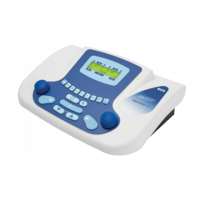Quick Start Guide
SIBELSOUND 400
Congratulations for purchasing an audiometer from SIBELMED, a leading company in the sector.
To optimise the use of this device, please refer to the USER'S MANUAL.
The SIBELSOUND 400
clinical audiometer is a compact two-channel device, the main components of which are a tone
generator, a noise generator, a set of earphones for air conduction, a vibrator for bone conduction
and an alphanumeric liquid crystal screen.
The whole system is controlled by a Digital Signal Processor DSP that allows audiometric
examination to be carried out quickly, simply and reliably to establish hearing thresholds and to
carry out screening tests such as suprathreshold tonal tests.
INSTALLATION
Install the device somewhere:
- With a 90V - 264V mains outlet and ground connection (required power is < 50 VA).
- With room temperature between 10 ºC and 40 ºC.
- With relative humidity lower than 90% without condensation.
- Next to a soundproof cabin or in a room with a very low level of ambient noise (another possibility is
placing noise dampers in the earphones).
- Away from possible splashes of water or any other liquid.
- Free from objects that prevent air ow during operation.
MENUS
The audiometer has several options that can be accessed by pressing the key, as follows:
1. TESTS 2. CONFIGURATION 3. MAINTENANCE 4. DATABASE*
- 1. TONE - 1. SAVE CONFIG. - 1. TEST DEVICE - 1. Display
- 2. Sisi* - 2. Modif Default - 1. CPU - 2. Delete DB
- 3. Speech* - 3. Reset Default - 2. LCD - 3. Find patient
- 4. Fowler* - 4. Diagnosis - 3. KEYBOARD - 4. Delete Patient.
- 5. Tone Decay* - 5. Sel. Freq. - 4. Printer
- 6. Luscher* - 1. Freq. Sel. - 5. Update key 5. REF TONE**
- 7. Weber* - 2. Musical Freq. - 6. Version 6. AUTO MASK
- 8. Pure Tone HF*- 6. Printer - 7. RESET DEVICE
- 9. Free - 7. Language - 2. CALIBRATION
- 8. CONTRAST - 1. ANSI / ISO
- 9. DATE - TIME - 2. CAL. WARNING
*Depending on models
- 3. CAL. DEFECT
** Permitted in models,
- 3. MONITOR*
AOM, AOM+ AND SUPRA
- 4. LOGO-INTER*
- 5. AUXILIARY*
Press or turn to move around the various options of the menu.
Press or to access the selected option and press to return to the
previous menu (press this key for more than 1 second to return to the screen of the selected test).
www.s ibe lm ed. com
www.s ibe lm ed. com
520-711-GR2 Rev. 1.01
SIBEL S.A., Rosselló 500, 08026 Barcelona (Spain)
Domestic Sales: Tel. 93 436 00 08 - E-mail: comercial@sibelmed.com
International Sales: Tel. +34 93 436 00 07 - E-mail: export@sibelmed.com
Technical Assistance: Tel. +34 93 433 54 50 - E-mail: sat@sibelmed.com
Fax: +34 93 436 16 11 www.sibelmed.com
Product class IIa according to Directive 93/42/EEC
SIBEL S.A. is a member of the
www.sibelgroup.com
A LGO C A LGO C
CONTIN. CONTIN.
+
A LGO C A LGO C
60 00/10 60
COMMON FUNCTIONS
+
(Press simulta-
TEST XXXXX
T H R E S H O L D S AV E D
NWF1:AUX/MICVD
10 03
NP F1: AUX/MIC VD
10 03
NWF1:AUX/MIC VD
10 03
+
or
A HZ C A HZ C
60 1000 60
TEST XXXXX
P R I N T I N G
TEST XXXXX
S AV E D
INTER CO M
E.TC 03 M.PA 03
Press F3, choose the presentation mode for the
signal: continuous (C), pulse (P) and press
o .
Choose the signal intensity.
Use F1 to choose the input device: auxiliary
(AUX) or technician microphone (MIC) and press
o o .
Choose the number of words (NW) and press
o o .
Choose the volume of the input device (VD):
auxiliary (AUX) or technician microphone (MIC) and
press o o .
Choose the number of correct words.
To set the counter to zero, press .
Applying the signal to the patient.
Choose inverted mode (the signal is enabled when
the SIGNAL key is not pressed).
Threshold memorisation.
Threshold revision, choose the conduction with
and the frequency with
Printing the audiometric report (the thresholds
have to be memorised).
Save a test to the database.
Accessing the Database menu if there are no
thresholds.
Activating the intercom (the patient receives
the signal from the technician microphone
and vice-versa). Choose the volume for the
technician's earphones (E.TC) and the
patient'smicrophone. (M.PA)
+ +
+ +
+ +
+
A --- XXX A ---
60 1000 60
1 s
1 s
1 s
A LGO C A LGO C
60 02/10 60

